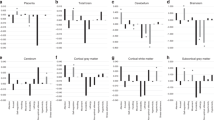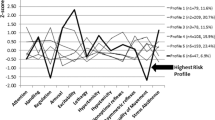Abstract
Objective
To describe differences in neurobehavior among very preterm infants with low medical risk at term equivalent age and full-term infants.
Study design
One-hundred eighty-six (136 infants born ≤32 weeks gestation with low medical risk at term equivalent age and 50 full-term infants within 4 days of birth) had standardized neurobehavioral assessments. Low medical risk was defined by ventilation <10 days and absence of significant brain injury, necrotizing enterocolitis, patent ductus arteriosus, and retinopathy of prematurity.
Results
Very preterm infants with low medical risk at term equivalent age demonstrated more sub-optimal reflexes (p < 0.001; ß = 1.53) and more stress (p < 0.001; ß = 0.08) on the NICU Network Neurobehavioral Scale compared to their full-term counterparts. Very preterm infants with low medical risk also performed worse on the Hammersmith Neonatal Neurological Examination (p = 0.005; ß = −3.4).
Conclusion
Very preterm infants at term equivalent age continue to demonstrate less optimal neurobehavior compared to full-term infants.
This is a preview of subscription content, access via your institution
Access options
Subscribe to this journal
Receive 12 print issues and online access
$259.00 per year
only $21.58 per issue
Buy this article
- Purchase on Springer Link
- Instant access to full article PDF
Prices may be subject to local taxes which are calculated during checkout




Similar content being viewed by others
Change history
11 July 2022
A Correction to this paper has been published: https://doi.org/10.1038/s41372-022-01454-x
References
Pascal A, Govaert P, Oostra A, Naulaers G, Ortibus E, Van den Broeck C. Neurodevelopmental outcome in very preterm and very-low-birthweight infants born over the past decade: a meta-analytic review. Dev Med Child Neurol. 2018;60:342–55.
Dean B, Ginnell L, Boardman JP, Fletcher-Watson S. Social cognition following preterm birth: a systematic review. Neurosci Biobehav Rev. 2021;124:151–67.
Pascoe L, Burnett AC, Anderson PJ. Cognitive and academic outcomes of children born extremely preterm. Semin Perinatol. 2021;45:151480.
McGowan EC, Hofheimer JA, O’Shea TM, Carter BS, Helderman J, Neal CR, et al. Sociodemographic and medical influences on neurobehavioral patterns in preterm infants: a multi-center study. Early Hum Dev. 2020;142:104954.
Brouwer MJ, Kersbergen KJ, van Kooij BJM, Benders M, van Haastert IC, Koopman-Esseboom C, et al. Preterm brain injury on term-equivalent age MRI in relation to perinatal factors and neurodevelopmental outcome at two years. PLoS ONE. 2017;12:e0177128.
Woythaler M. Neurodevelopmental outcomes of the late preterm infant. Semin Fetal Neonatal Med. 2019;24:54–9.
Ballantyne M, Benzies KM, McDonald S, Magill-Evans J, Tough S. Risk of developmental delay: comparison of late preterm and full term Canadian infants at age 12 months. Early Hum Dev. 2016;101:27–32.
Cheong JL, Doyle LW, Burnett AC, Lee KJ, Walsh JM, Potter CR, et al. Association Between Moderate and Late Preterm Birth and Neurodevelopment and Social-Emotional Development at Age 2 Years. JAMA Pediatr. 2017;171:e164805.
Romeo DM, Ricci M, Picilli M, Foti B, Cordaro G, Mercuri E. Early Neurological Assessment and Long-Term Neuromotor Outcomes in Late Preterm Infants: a critical review. Medicina (Kaunas). 2020;56:475.
Yaari M, Mankuta D, Harel-Gadassi A, Friedlander E, Bar-Oz B, Eventov-Friedman S, et al. Early developmental trajectories of preterm infants. Res Dev Disabil. 2018;81:12–23.
Murray AL, Scratch SE, Thompson DK, Inder TE, Doyle LW, Anderson JF, et al. Neonatal brain pathology predicts adverse attention and processing speed outcomes in very preterm and/or very low birth weight children. Neuropsychology 2014;28:552–62.
Campbell S, Osten ET, Kolobe THA, Fisher AG. Developent of the Test of Infant Motor Performance. Phys Med Rehabilitation Clin North Am. 1993;4:541–50.
Daily DK, Ellison PH. The premie-neuro: a clinical neurologic examination of premature infants. Neonatal Netw. 2005;24:15–22.
Dubowitz L, Ricciw D, Mercuri E. The Dubowitz neurological examination of the full-term newborn. Ment Retard Dev Disabil Res Rev. 2005;11:52–60.
Lester BM, & Tronick, E. NICU Network Neurobehavioral Scale (NNNS). Baltimore: Paul H. Brookes Pub. Co.; 2004.
Washington K. The Bayley Scales of Infant Development-II and children with developmental delays: a clinical perspective. J Dev Behav Pediatr. 1998;19:346–9.
Chin EYJ, Baral VR, Ereno IL, Allen JC, Low K, Yeo CL. Evaluation of neurological behaviour in late-preterm newborn infants using the Hammersmith Neonatal Neurological Examination. J Paediatr Child Health. 2019;55:349–57.
de Souza Perrella VV, Marina Carvalho de Moraes B, Sanudo A, Guinsburg R. Neurobehavior of preterm infants from 32 to 48 weeks post-menstrual age. J Perinatol. 2019;39:800–7.
Pineda RG, Tjoeng TH, Vavasseur C, Kidokoro H, Neil JJ, Inder T. Patterns of altered neurobehavior in preterm infants within the neonatal intensive care unit. J Pediatrics. 2013;162:470–6.e1.
Madlinger-Lewis L, Reynolds L, Zarem C, Crapnell T, Inder T, Pineda R. The effects of alternative positioning on preterm infants in the neonatal intensive care unit: a randomized clinical trial. Res Dev Disabil. 2014;35:490–7.
Pineda R, Durant P, Mathur A, Inder T, Wallendorf M, Schlaggar BL. Auditory Exposure in the Neonatal Intensive Care Unit: Room Type and Other Predictors. J Pediatr. 2017;183:56–66.e3.
Pineda R, Heiny E, Nellis P, Smith J, McGrath JM, Collins M, et al. The Baby Bridge program: A sustainable program that can improve therapy service delivery for preterm infants following NICU discharge. PLoS ONE. 2020;15:e0233411.
Pineda R, Smith J, Roussin J, Wallendorf M, Kellner P, Colditz G. Randomized clinical trial investigating the effect of consistent, developmentally-appropriate, and evidence-based multisensory exposures in the NICU. J Perinatol. 2021;41:2449–62.
Pineda R, Wallendorf M, Smith J. A pilot study demonstrating the impact of the supporting and enhancing NICU sensory experiences (SENSE) program on the mother and infant. Early Hum Dev. 2020;144:105000.
Pineda R, Bender J, Hall B, Shabosky L, Annecca A, Smith J. Parent participation in the neonatal intensive care unit: Predictors and relationships to neurobehavior and developmental outcomes. Early Hum Dev. 2018;117:32–8.
Drougia A, Giapros V, Krallis N, Theocharis P, Nikaki A, Tzoufi M, et al. Incidence and risk factors for cerebral palsy in infants with perinatal problems: a 15-year review. Early Hum Dev. 2007;83:541–7.
Hickey M, Georgieff M, Ramel S. Neurodevelopmental outcomes following necrotizing enterocolitis. Semin Fetal Neonatal Med. 2018;23:426–32.
Gotardo JW, Volkmer NFV, Stangler GP, Dornelles AD, Bohrer BBA, Carvalho CG. Impact of peri-intraventricular haemorrhage and periventricular leukomalacia in the neurodevelopment of preterms: A systematic review and meta-analysis. PLoS ONE. 2019;14:e0223427.
Ricci D, Lucibello S, Orazi L, Gallini F, Staccioli S, Serrao F, et al. Early visual and neuro-development in preterm infants with and without retinopathy. Early Hum Dev. 2020;148:105134.
Lester BM, Tronick EZ, Brazelton TB. The Neonatal Intensive Care Unit Network Neurobehavioral Scale procedures. Pediatrics 2004;113:641–67.
Dubowitz L, Mercuri E, Dubowitz V. An optimality score for the neurologic examination of the term newborn. J Pediatr. 1998;133:406–16.
Eeles AL, Olsen JE, Walsh JM, McInnes EK, Molesworth CM, Cheong JL, et al. Reliability of Neurobehavioral Assessments from Birth to Term Equivalent Age in Preterm and Term Born Infants. Phys Occup Ther Pediatr. 2017;37:108–19.
Spittle AJ, Walsh J, Olsen JE, McInnes E, Eeles AL, Brown NC, et al. Neurobehaviour and neurological development in the first month after birth for infants born between 32-42 weeks’ gestation. Early Hum Dev. 2016;96:7–14.
Brown NC, Doyle LW, Bear MJ, Inder TE. Alterations in neurobehavior at term reflect differing perinatal exposures in very preterm infants. Pediatrics 2006;118:2461–71.
Matthews LG, Walsh BH, Knutsen C, Neil JJ, Smyser CD, Rogers CE, et al. Brain growth in the NICU: critical periods of tissue-specific expansion. Pediatr Res. 2018;83:976–81.
Hedderich DM, Bauml JG, Menegaux A, Avram M, Daamen M, Zimmer C, et al. An analysis of MRI derived cortical complexity in premature-born adults: Regional patterns, risk factors, and potential significance. Neuroimage 2020;208:116438.
Kline JE, Illapani VSP, Li H, He L, Yuan W, Parikh NA. Diffuse white matter abnormality in very preterm infants at term reflects reduced brain network efficiency. Neuroimage Clin. 2021;31:102739.
Brenner RG, Wheelock MD, Neil JJ, Smyser CD. Structural and functional connectivity in premature neonates. Semin Perinatol. 2021;45:151473.
van Dokkum NH, de Kroon MLA, Reijneveld SA, Bos AF. Neonatal Stress, Health, and Development in Preterms: a systematic review. Pediatrics. 2021;148:e2021050414.
Cheong JLY, Burnett AC, Treyvaud K, Spittle AJ. Early environment and long-term outcomes of preterm infants. J Neural Transm (Vienna). 2020;127:1–8.
Lester BM, Tronick E. NICU Network Neurobehavioral Scale (NNNS) Manual. Baltimore:Paul H. Brookes Pub. Co.; 2004.
Pineda R, Liszka L, Inder T. Early neurobehavior at 30 weeks postmenstrual age is related to outcome at term equivalent age. Early Hum Dev. 2020;146:105057.
Acknowledgements
We would like to thank Zachary Vesoulis, Amit Mathur, Jeffrey Neil, Jessica Roussin, Sarah Oberle, Molly Grabill, Maggie Meether, Danielle Prince, Polly Kellner, Marinthea Richter, Bethany Gruskin, and Delaney Smith.
Funding
This work was supported by the National Institute of Health ROI HD 057098 and Comprehensive Opportunities for Rehabilitation Research Training (K12 HD055931), Eunice Kennedy Shriver National Institute of Child Health and Human Development (U54 HD087011) to the Intellectual and Developmental Disabilities Research Center at Washington University (NIH/ NICHD P30 HD062171), the Gordon and Betty Moore Foundation, the Washington University Institute of Clinical and Translational Sciences Clinical and Translational Funding Program (National Institutes of Health/National Center for Advancing Translational Sciences UL1 TR000448), and the National Institute of Health R24 (5R24HD065688‐05) awarded to the Boston Rehabilitation Outcomes Center.
Author information
Authors and Affiliations
Contributions
All of the authors are responsible for the reported research. All of the authors have participated in the concept and design, analysis and interpretation of data, drafting or revision of the paper, and they have approved the paper as submitted.
Corresponding author
Ethics declarations
Competing interests
The authors declare no competing interests.
Additional information
Publisher’s note Springer Nature remains neutral with regard to jurisdictional claims in published maps and institutional affiliations.
The original online version of this article was revised: The article title has been corrected.
Rights and permissions
About this article
Cite this article
Pineda, R., Liszka, L., Tran, P. et al. Neurobehavior in very preterm infants with low medical risk and full-term infants. J Perinatol 42, 1400–1408 (2022). https://doi.org/10.1038/s41372-022-01432-3
Received:
Revised:
Accepted:
Published:
Issue Date:
DOI: https://doi.org/10.1038/s41372-022-01432-3



